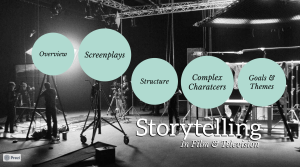26 The Screenplay
Learning Objectives
-
Understand the screenplay as the basis of storytelling in film, including its structure and goals, such as character development.
-
Develop skills to communicate, collaborate, solve problems, learn and demonstrate creativity using technology.
Chapter & Discussion
This chapter includes a presentation that can be navigated in a classroom setting or independently. You can access the presentation via the link below.
The Screenplay: Storytelling in Film
Work through the different sections of the chapter and discuss ideas and topics as they arise. If you’re working independently, take notes instead. Notes and active discussion will be helpful in navigating this week’s assignments.
Overview
The big goal of this course to to find a way to practice our reading skills while living our everyday lives.
Our worlds are full of stories. We can see the elements of literature in our experiences and through our relationships. And, since literature’s main goal is practicing empathy, this can help us navigate our social worlds.
Film and television can be a part of this journey as well. They share many, many elements in common with literature. When we watch films and television, we can use the same critical thinking skills we do when we read. If we use the language of literature to think and talk about film and television, we are practicing our ready skills every time we watch.

Screenplays
Screenplays communicate an entire cinematic world in a tightly written format focused only on essential details. Description is limited to critical information like interior or exterior, day or night, brief indications of characters and settings – just enough for the crew to interpret the visualization. Dialogue advances plot and reveals character arcs efficiently. Action describes only necessary story events.
This compressed style means each page equals about one minute of screen time. This allows creative freedom for the director and crew to flesh out specifics not spelled out on the page while ensuring economical narrative flow. Different from written fiction, screenplays are read as blueprints for a final film.
Structure
The three-act structure has proven an effective spine for cinematic storytelling. Act One sets up the hero and their goal through an inciting incident. Act Two creates escalating obstacles that seem to stand in the way of the goal, often with a low point where the hero doubles down. Act Three culminates in a climax where the hero overcomes all odds to achieve their goal (or not).
One protagonist + one goal + a whole bunch of obstacles
This satisfying arc builds audience expectations via conventions then allows innovation on the details – how this specific story solves the dramatic question. The protagonist can be drawn through confrontations that force change. Structure often conveys ideas more than the specifics of the plot.
Complex Characters
Compelling protagonists captivate cinema audiences, driving narrative through confronting escalating obstacles. In these characters, transformation proves more compelling than static heroes. Since films often follow multiple protagonists, the contrast between their characters and transformations can be really interesting to audiences.
In film, the camera operates as the story’s narrator – dictating point of view, restricting information, guiding attention where and when the director chooses. So the complex arc of the central character coupled with the camera’s selective gaze combine to draw viewers deeply into onscreen stories, creating an intimacy unique to the medium.

Goals and Themes
We write because we have something to say.
An underlying narrative idea or theme ties together great films beyond a mere sequence of events. Not just spectacle but an idea conveyed through the plot arc and character choices.
Every element of literature, the setting, the characters, and the plot, help to communicate the themes through metaphors (for example, the setting of the Little Mermaid help us better understand what it means to be a teenager).
The film’s goals and themes inform production design decisions around sets, lighting, cinematography, music, and editing. Allowing them to build tension, reveal character, advance the story. Without clear narrative intent, cinematic craft risks feeling disjointed rather than escalating emotion and meaning.
Assigned Reading
Here are this week’s readings. Additionally, please read for your own personal enjoyment for 1/2 hour each day. This will be called your “Reading Zone” reading and it will coincide with many upcoming activities.
Narrative by Russel Sharman (via Moving Pictures)
Problem Set: Practice Your Skills!
Click here to complete a ten-question problem set on concepts in this chapter.
Completing problem sets like this can be an important element of independent study towards completing your HSE. I write these to resemble the style of questions you’ll find on the Reading and Language Arts GED.
Assignment: Narrative Arc
Make a copy of this chart in your notebook. The chart (by Russel Sharman via Moving Pictures) describes the narrative arc of a screenplay. Fill in the details with the story milestones from a movie of your choice.
Then, complete the chart again for your Reading Zone book. If you haven’t finished your book, make predictions about the parts you haven’t made it to yet.
Assignment: Reading Zone Response (250 Words)
For Reading Zone, you must find a novel that is interesting to you and enjoyable to read. If you need help finding a Reading Zone book, please ask. Please read your Reading Zone book for a half-hour each day. On class days, there will be time in class dedicated to reading.
Create a response to this week’s reading that addresses the following prompts:
-
In one paragraph, summarize what you’ve read this week
-
In a second paragraph, tell me about the characters in your book. Would you say they are round or flat? Explain.
Attributions
Sharman, R. Moving Pictures. University of Arkansas Libraries Open Educational Materials. 2020.
Willems, P.H. How to Analyze Movies. Nebula. Jan 30, 2023.


